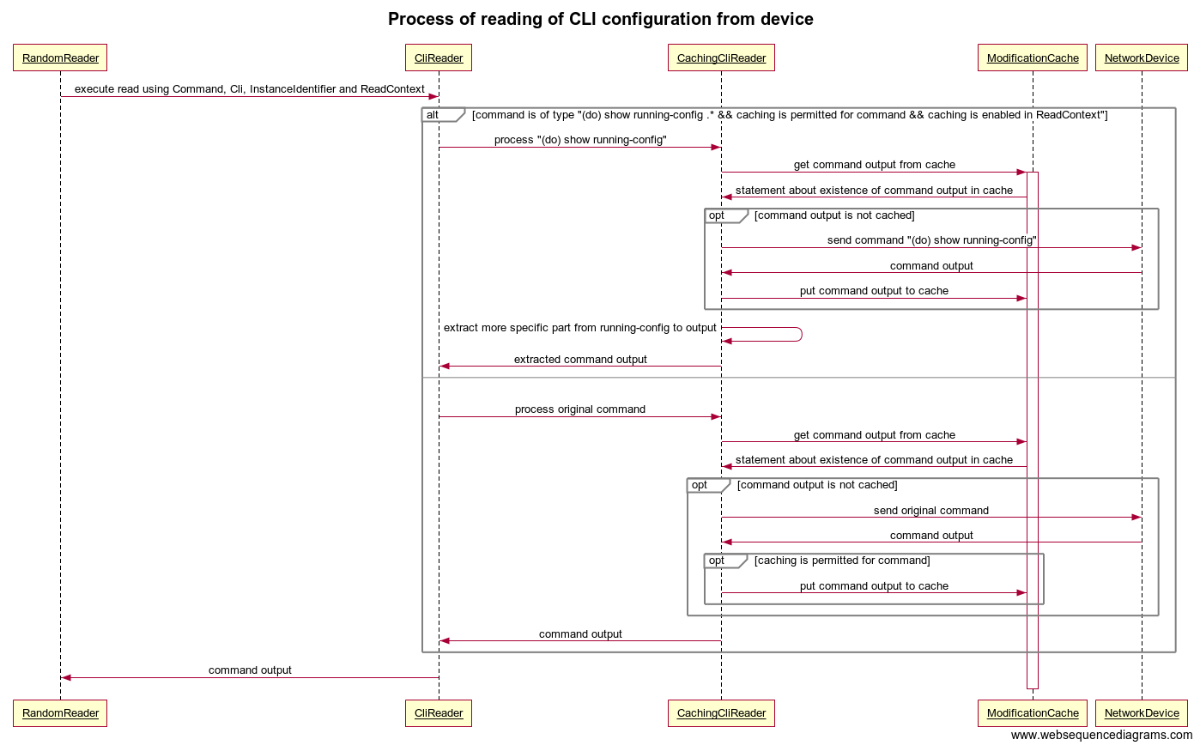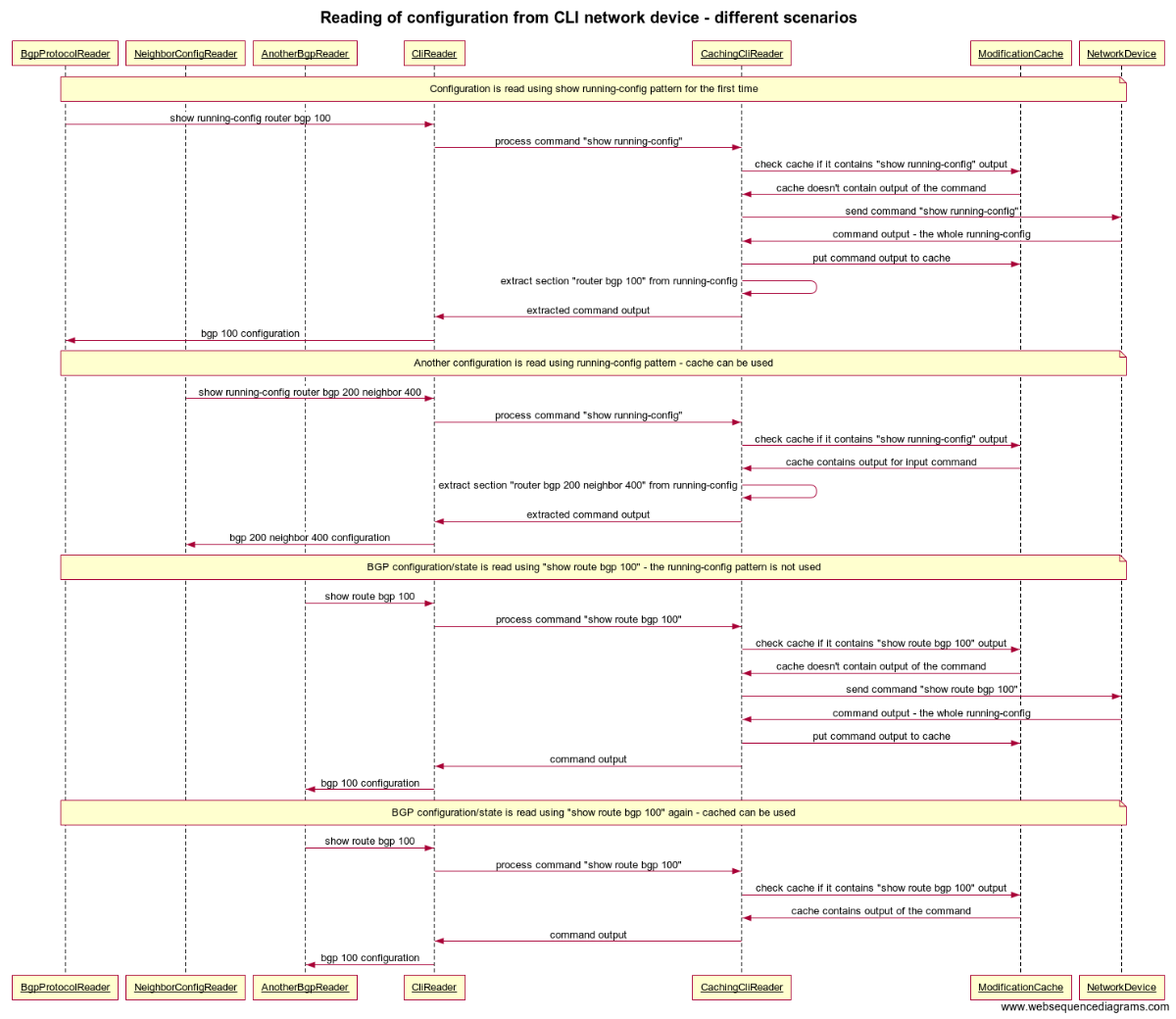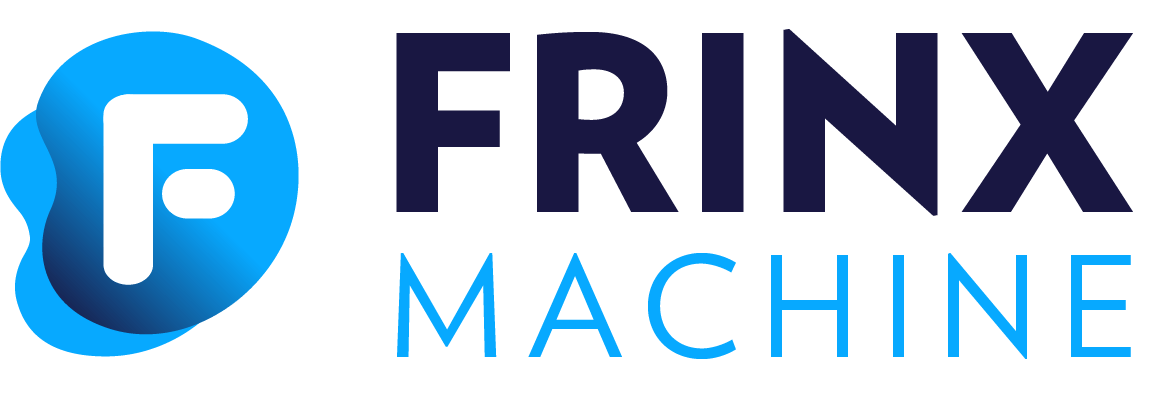#
Implementing CLI Translation Unit
CLI Translation units are located in https://github.com/FRINXio/cli-units repository. Java is used in CLI translation units.
#
Init Unit
Init translation unit does not contain readers and writers but it only contains implementation of TranslateUnit. There should be only one init translation unit per device type. Purpose of the init TU is to setup CLI prompt and define rollback strategy.
The implementation of TranslateUnit needs to override methods:
SessionInitializationStrategy getInitializer(@Nonnull final RemoteDeviceId id, @Nonnull final CliNode cliNodeConfiguration)
Implement and return device specific SessionInitializationStrategy where:
- Setup device CLI terminal with attributes like width and length allowing to display infinite output.
- Enter desired CLI mode which will be used as default - every reader and writer gets CLI prompt in this state (e.g. EXEC mode for IOS, config mode for IOS-XR, cli mode for Junos)
These methods may be overridden if necessary:
getPreCommitHook() - method that is invoked before actual commit is written into device. For example this method can enter configuration mode.
getCommitHook() - method that invokes actual commit and should catch any error on commit. Also it should handle any post-commit actions when the commit was successful.
getPostFailedHook() - method that is invoked when commit fails. Should implement aborts or revert strategies.
getErrorPatterns() - method returning Java Patterns with regular expressions that match device specific error patterns.
getCommitErrorPattern() - method returning Java Patterns with regular expressions that match device specific error patterns that can be returned by the device after issuing commit.
#
Translate Unit
Translate unit class must implement interface io.frinx.cli.unit.utils.AbstractUnit. Naming convention for translate unit class is device-type+openconfig-domain+Unit (e.g. IosXrInterfaceUnit). Translate unit class is usually instantiated, initialized and closed from Blueprint.
Implementation of TranslateUnit must be registered into TranslationUnitCollector and must specify device type and device version during registration. Snippet below shows registration of IosXRInterfaceUnit for device type "ios xr" all versions.
private final TranslationUnitCollector registry;
private TranslationUnitCollector.Registration reg;
public IosXRInterfaceUnit(@Nonnull final TranslationUnitCollector registry) {
super(registry);
}
@Override
protected Set<Device> getSupportedVersions() {
return IosXrDevices.IOS_XR_ALL;
}
@Override
protected String getUnitName() {
return "IOS XR Interface (Openconfig) translate unit";
}
@Override
public void provideHandlers(@Nonnull CustomizerAwareReadRegistryBuilder readRegistry,
@Nonnull CustomizerAwareWriteRegistryBuilder writeRegistry,
@Nonnull Context context) {
Cli cli = context.getTransport();
provideReaders(readRegistry, cli);
provideWriters(writeRegistry, cli);
}Implementation of TranslateUnit must implement these methods:
String getUnitName()
Return unique string among all translation units which will be used as ID for the translation unit (e.g. "IOS XR Interface (Openconfig) translate unit")
Set getYangSchemas()
Return YANG models containing composite nodes handled by handlers(readers/writers). Default implementation returns empty Set if no handlers are implemented.
Set getRpcs(@Nonnull Context context)
Return RPC services implemented in the translation unit. Parameter context.getTransport() returns Cli object containing methods for communication with a device via CLI - may need to be passed to RPC implementations. Default implementation returns empty Set.
Set<Device> getSupportedVersions()
This method should return specific device version that work with this handler.
void provideHandlers()
Handlers(readers/writers) need to be registered in this method. Parameter context.getTransport() returns Cli object containing methods for communication with a device via CLI - should be passed to readers/writers.
This method should also registers for general Openconfig checks:
CheckRegistry checkRegistry = ChecksMap.getOpenconfigCheckRegistry();
readRegistry.setCheckRegistry(checkRegistry);
writeRegistry.setCheckRegistry(checkRegistry);Instance-identifier in generic reader/writer must be without keys pointing to the target composite node used in implemented reader/writer.
Instance-identifiers for YANG container and list (not for augmentations and nodes behind augmentations) are automatically generated to IIDs class (used in examples bellow) during build of openconfig project.
#
Ordering of handlers
Writers are stored in a linear structure and are invoked in order of registration. When registering a writer a relationship with another writer or set of writers can be expressed using addBefore, addAfter, subtreeAddBefore, subtreeAddAfter methods. E.g. InterfaceWriter and VRFInterfaceWriter should have a relationship: InterfaceWriter -> VRFInterfaceWriter so that first an interface is created and only then assigned to VRF.
VRF writer should be between them. If the order is not expressed during registration, commands might be executed on device in an unpredictable/invalid order.
The following sample shows a CLI translation unit with dependency between 2 writers. The unit is dedicated for interface configuration on a Cisco IOS device.
R2(config)#interface loopback 1
R2(config-if)#ip address 10.0.0.1 255.255.255.255As the example shows, the ip address command must be executed after the interface command.
Registration of Ipv4ConfigWriter by using the addAfter method ensures that the OpenConfig ip address data is translated after OpenConfig interface data. That means CLI commands are executed in the desired order.
rRegistry.add
Use when common GenericConfigListReader, GenericConfigReader, *GenericOperListReader or GenericOperReader need to be registered.
rRegistry.add(IIDs.IN_INTERFACE, new InterfaceReader(cli));rRegistry.addNoop
Use to register noop writers
rRegistry.addNoop(IIDs.IN_IN_CONFIG);rRegistry.subtreeAdd
Use when a reader implementation also fills composite child nodes of target composite node. Method subtreeAdd requires a set of IIDs for all handled children.
rRegistry.subtreeAdd(IIDs.IN_IN_AUG_INTERFACE1_ET_CONFIG, new EthernetConfigReader(cli),
Sets.newHashSet(IIDs.IN_IN_ET_CO_AUG_CONFIG1,
io.frinx.openconfig.openconfig.lacp.IIDs.IN_IN_ET_CO_AUG_LACPETHCONFIGAUG);wRegistry.add
Use when common GenericListWriter or GenericWriter are registered.
wRegistry.add(IIDs.IN_IN_CONFIG, new InterfaceConfigWriter(cli));wRegistry.subtreeAdd
Use for writers handling data of whole composite node subtrees. This ensures that if only a child node is updated, the writer gets triggered. Method subtreeAdd requires a set of IIDs for all handled children, the IIDs must start from the reader itself, not from root.
wRegistry.subtreeAddAfter(IIDs.IN_IN_AUG_INTERFACE1_ET_CONFIG, new EthernetConfigWriter(cli),
Sets.newHashSet(IIDs.IN_IN_ET_CO_AUG_CONFIG1,
io.frinx.openconfig.openconfig.lacp.IIDs.IN_IN_ET_CO_AUG_LACPETHCONFIGAUG),
IIDs.IN_IN_CONFIG);This example uses method subtreeAddAfter instead of subtreeAdd. Last parameter in this method shows dependency on writer registered under IIDs.IN_IN_CONFIG.
#
Device registration
In TranslateUnit we had just created, e.g. MplsUnitXR4.java, we have to register device as a constant located ../iosxr/init/IosXrDevices.java containing device type and version as described in TranslateUnit <cli-translation-unit-translate-unit> documentation.
public void init() {
reg = registry.registerTranslateUnit(IOS_4, this);
}This unit can reuse all writers/readers from existing ones, except the writer (or other handler) we want to alter or create (in our example writer for tunnel configuration). We have to create a new writer with desired behaviour and add it into provideWriters method.
private void provideWriters(ModifiableWriterRegistryBuilder wRegistry, Cli cli) {
wRegistry.add(IIDs.NE_NE_MP_LS_CO_TU_TU_CONFIG, new TunnelConfigWriterXR4(cli));
}
#
Readers
Readers are handlers responsible for reading and parsing the data coming from a device
There are 2 types of readers: Reader and ListReader. Reader can be used to handle container or augmentation nodes and ListReader should handle list nodes from YANG.
- Both types need to implement readCurrentAttributes to fill the builder with appropriate values
- ListReader needs to also implement getAllIds() where it retrieves a key for each item to be present in current list. After the list is received, framework will invoke readCurrentAttributes for each item from getAllIds
Readers should always use overloaded blockingRead method which takes in the ReadContext since that method performs caching internally
Use full version of commands e.g. show running-config interface instead of sh run int
#
Reading of CLI and device configuration
CLI readers maintain translation between device and yang models. We're sending read commands to the device and outputs are cached. This process is shown below.

#
Reading of configuration from CLI network device - different scenarios
The diagram below shows four specific scenarios:
- Configuration is read using show running-config pattern for the first time
- Another configuration is read using running-config pattern
- cache can be used
- BGP configuration/state is read using "show route bgp 100"
- the running-config pattern is not used
- BGP configuration/state is read using "show route bgp 100" again
- cached can be used

#
Mandatory interfaces to implement
Each reader needs to implement one of these interfaces based on type of target node in YANG. These interfaces also contain util methods which may be used for better manipulation with data. For more information about methods please read javadocs.
CliConfigListReader - implement this interface if target composite node in YANG is list and represents config data.
CliConfigReader - implement this interface if target composite node in YANG is container or augmentation and represents config data.
CliOperListReader - implement this interface if target composite node in YANG is list and represents operational data.
CliOperReader - implement this interface if target composite node in YANG is container or augmentation and represents operational data.
In cases where you want to invoke multiple readers on reading one YANG node, extend following abstract classes:
CompositeListReader - extend this abstract class if multiple list readers need to be invoked when reading specific list in YANG.
CompositeReader - extend this abstract class if multiple readers need to be invoked when reading specific node in YANG.
A practical example of their usage is reading network instance based on it's type. All child readers need to implement a check when the particular reader should be invoked or the parent reader should move on to the next reader.
For example child reader for bgp (located under protocol) needs to check if identifier in protocol has value BGP. Otherwise reader for bgp will be invoked even if protocol identifier is OSPF.
#
Util classes
ParsingUtils - use methods of this util class if you want to parse plaintext to java object builder
#
Plaintext parsing hints
Use as specific regular expressions when parsing CLI output as possible.
For Cisco CLI devices avoid using section and other advanced
formatting parameters. Only include, exclude and begin
are allowed.
Use CONFIG data as the source of truth when parsing information from device. Except when parsing state containers (or containers explicitly marked as config false).
- I.e. use
show running-config | include router ospfinstead ofsh ospfwhen retrieving ospf routers list. - In some cases, it is not possible to just use config data e.g. sh
run interface does not show any data for interfaces that have no
configuration. In this case it is necessary to use operational
information from e.g.
show ip interface brief
Use following pattern when parsing multiline output from CLI, where it is difficult to extract lines and their relationships: i.e. when parsing configured BGP neighbors per address family following command can be used:
show running-config | include ^router bgp | ^ address-family |^ neighbor``which results in:
router bgp 65000
address-family ipv4 vrf vrf1
neighbor 1.2.3.4 remote-as 65000>
neighbor 1.2.3.4 activate
address-family ipv4 vrf vrf2
neighbor 2.2.0.1 remote-as 65000
neighbor 2.2.0.1 activateThis output can then be parsed by:
- Remove newlines to get a single line of string
- Replace "router" with "" to separate bgp routers per line
- Find the line that matches required router bgp
- Take that line and replace "address-family" with "-family" to get address-family neighbors per line
#
Base Readers
Each base reader should contain abstract methods:
- String getReadCommand(<args>) - each child reader should fill in the read command used to get information needed for this reader. Arguments may vary and they are used to be more specific in the read command (eg. when creating a command to gather information about a specific interface, you may want to pass interface name as argument).
- Pattern get<command>Line(>) - there may be more such methods and they are used to get the regular expression needed to parse output of the command (eg. in case of interface reader, you will create methods getDescriptionLine, getShutdownLine etc.)
Naming of the methods should be unified in order to be easily parsed by auto-generated documentation.
#
Writers
A writer needs to implement all 3 methods: Write, Update, Delete in order to fully support default rollback mechanism of the framework
Time showed that update like 1. delete, 2. write is anti-pattern and should not be used. There is just one case where it is necessary: when re-writing list entry, you must first delete the previous entry, then write the new one, otherwise the previous entry would still be present and the new entry will be added to the list.
A writer can properly work only if there is a reader for the same composite node.
A writer should check whether the command it executed was handled by the device properly (by checking the output) and if not throw one of the Write/Update/Delete FailedException
Chunk templating framework is preferred to use in writers. It gives us:
- Null safety
- if/loop etc. inside templates
- Default values and many more
Use full version of commands e.g. configure terminal instead of
conf t
#
Mandatory interfaces to implement
Each writer needs to implement one of these interfaces based on type of target node in YANG. Unlike mandatory interfaces for reading, only interfaces for writing config data are available (because it is not possible to write operational data). These interfaces also contain util methods which may be used for better manipulation with data. For more information about methods please read javadocs.
All writers override updateCurrentAttributes method and avoid delete/write combination, unless specified in a comment.
CliListWriter - implement this interface if target composite node in YANG is list. An implementation needs to be registered as GenericListWriter.
CliWriter - implement this interface if target composite node in YANG is container or augmentation. An implementation needs to be registered as GenericWriter.
CompositeWriter - extend this abstract class when multiple writers need to be invoked on one YANG node. The writers need to implement a check whether or not should they be invoked.
#
Base Writers
Each base writer should contain abstract methods:
- String updateTemplate(Config before, Config after) this method returns Chunk template used for writing and updating data on the device.
- String deleteTemplate(Config data) this method returns Chunk template used for deleting data from device.
If updating data is done differently than writing new data, method String writeTemplate(Config data) might be used as well.
#
Chunk Templates
Each original writer transformed to use a base writer should have all it's templates written in Chunk. We extended Chunk to achieve easier manipulation with data. There is now a new filter called update. It's usage is following:
"{$data|update(mtu,mtu $data.mtu, no mtu)}"
- $data represents the data structure on which we check if it was updated from the previous state.
- mtu first argument represents the name of the field that should be checked within the $data
- $data.mtu second argument represents the actual string that will be sent to the device if the value of the field named in first argument was changed or didn't exist before
- no mtu third argument represents the actual string that will be sent to the device if the value of the field named in first argument was deleted
- optional true fourth argument, if present, lets the filter know it should send both outputs to the device, first the delete string (third argument) then the update string (second argument)
Update filter does not send any of the strings to the device, if the value did not change.
When using this filter in updateTemplate method, you must use fT() method (format template) with one pair of the arguments being "before", before to let the template know what data represents the previous state.
Unfortunately, Opendaylight generates boolean fields instead of Boolean and Chunk does not work with boolean fields in the same way as any other object fields. Therefore for boolean values (eg. shutdown), you cannot use update filter and checking for changes needs to be done in a traditional way.
